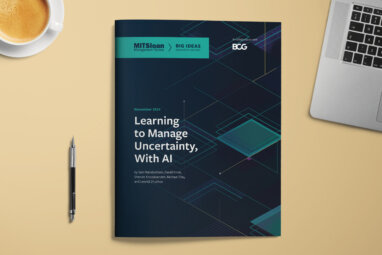The New Elements of Digital Transformation
The authors revisit their landmark research and address how the competitive advantages offered by digital technology have evolved.

Image courtesy of Michael Glenwood Gibbs/theispot.com
Since 2014, when our article “The Nine Elements of Digital Transformation” appeared in these pages, executive awareness of the powerful and ever-evolving ways in which digital technology can create competitive advantage has become pervasive.1 But acting on that awareness remains a challenging prospect.
It requires that companies become what we call digital masters. Digital masters cultivate two capabilities: digital capability, which enables them to use innovative technologies to improve elements of the business, and leadership capability, which enables them to envision and drive organizational change in systematic and profitable ways. Together, these two capabilities allow a company to transform digital technology into business advantage.2
Digital mastery is more important than ever because the risks of falling behind are increasing. In 10 years of research, we have seen digital transformation grow increasingly complex, with a new wave of technological and competitive possibilities arriving before many companies mastered the first. When we began our research, most large traditional enterprises were using digital technologies to incrementally improve parts of their businesses. Since then, this first phase of activity has given way to a new one. Advances in a host of technologies, such as the internet of things, artificial intelligence, virtual and augmented reality, and 5G, have opened new avenues for value creation. More important, leaders now recognize the need for — and the possibility of — truly transforming the fundamentals of how they do business. They understand that they have to move from disconnected technology experiments to a more systematic approach to strategy and execution.
References (23)
1. G. Westerman, D. Bonnet, and A. McAfee, “The Nine Elements of Digital Transformation,” MIT Sloan Management Review, Jan. 7, 2014, https://sloanreview.mit.edu.
2. G. Westerman, D. Bonnet, and A. McAfee, “Leading Digital: Turning Technology Into Business Transformation” (Boston: Harvard Business Review Press, 2014); G. Westerman, M. Tannou, D. Bonnet, et al., “The Digital Advantage: How Digital Leaders Outperform Their Peers in Every Industry,” Capgemini Consulting and MIT Center for Digital Business, Nov. 5, 2012, www.capgemini.com; and G. Westerman, C. Calmejane, D. Bonnet, et al., “Digital Transformation: A Roadmap for Billion-Dollar Organizations,” Capgemini Consulting and MIT Center for Digital Business, Nov. 17, 2011, www.capgemini.com.




